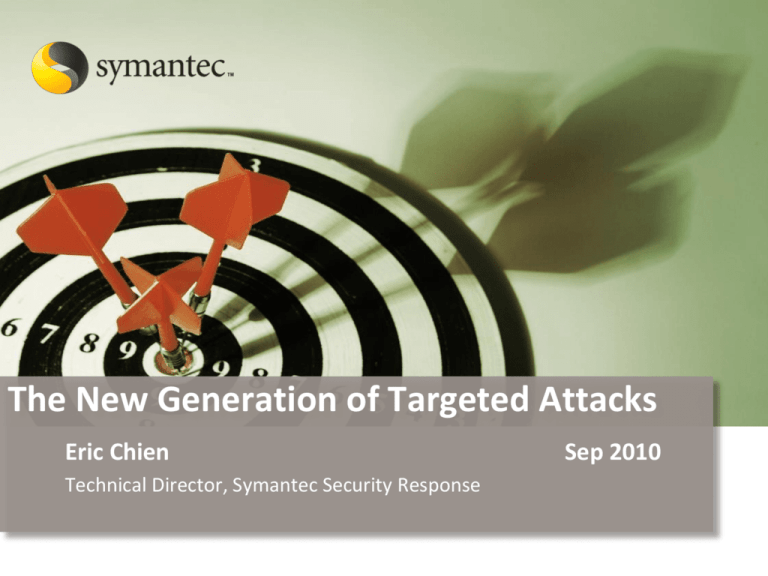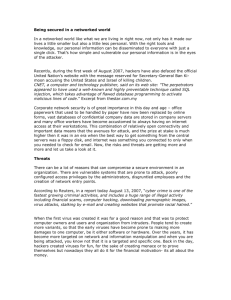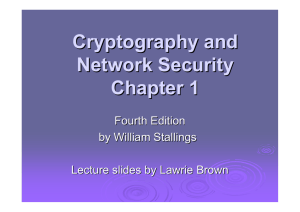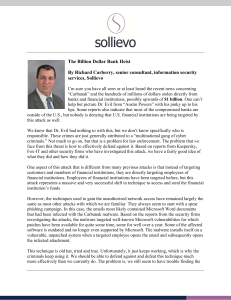
The New Generation of Targeted Attacks
Eric Chien
Sep 2010
Technical Director, Symantec Security Response
1
Targeted attacks are similar malicious
threats sent to a narrow set of recipients based
on their employment industry or direct
involvement in an organization to gain access
to intellectual property and confidential
documents.
.
RAID 2010 - The New Generation of Targeted Attacks
2
Agenda
1
Overview
• A Walk Through the Malware History
• History of Targeted Attacks
• The Methodology of Targeted Attacks
2
A Closer Look
• Aurora (Hydraq)
• Demonstration
• Stuxnet
3
Defense
• Protection Challenges
• Summary
RAID 2010 - The New Generation of Targeted Attacks
3
History of Malware
RAID 2010 - The New Generation of Targeted Attacks
4
First IBM PC virus:
Brain boot sector virus
created in Pakistan
1986
1987
The Era of Discovery
1988
First DOS File Infector:
Virdem presented at the
Chaos Computer Club
RAID 2010 - The New Generation of Targeted Attacks
1989
1990
1991
First Polymorphic Virus:
Chameleon developed by
Ralf Burger
5
CIH:
A Windows file infector that
would flash the BIOS
Michaelangelo trigger date:
Causes widespread media
panic that computers would
be unbootable
1992
1993
The Era of Transition
1994
1995
1996
1997
1998
First Word Macro virus:
Concept is the first macro
virus infected Microsoft
Word documents
RAID 2010 - The New Generation of Targeted Attacks
6
Blended Threats:
CodeRed, Nimda spread
without any user
interaction using Microsoft
system vulnerabilities
Worm wars:
MyDoom, Netsky,
Sobig, all compete for
machines to infect
Email systems down:
The Melissa worm spreads
rapidly to computers via
email causing networks to
come to a crawl
The Era of Fame and Glory
1999
2001
2000
LoveLetter Worm:
First VBS script virus to
spread rapidly via
Outlook email
2002
Anna Kournikova:
Just another email
worm, but successful
in propagation using
racy pictures of Anna
Kournikova as bait
RAID 2010 - The New Generation of Targeted Attacks
2003
2004
2005
Samy My Hero:
XSS worm spreads on
MySpace automatically
friending a million users
7
Rogue AV:
Becomes ubiquitous
charging $50-$100 for
fake proteciton
Mebroot:
MBR rootkit that steals
user credentials and
enables spamming
Hydraq:
Targets multiple US
corporations in search
of intellectual property
The Era of Mass Cybercrime
2006
Zeus Bot:
Hackers botnet
executable of
choice -- steals
online banking
credentials
2007
2008
Storm Worm:
P2P Botnet for spamming
and stealing user
credentials
RAID 2010 - The New Generation of Targeted Attacks
2009
Stuxnet:
Targets industrial
control systems in Iran
2010
Koobface:
Spreads via social
networks and installs payper-install software
Conficker:
Spreads via MS08-067,
builds millions-sized
botnet to install pay-perinstall software
8
Solar Sunrise:
Attacks stealing passwords
from DoD systems
conducted by 2 Californian
and 1 Israeli teenager
1998
1999
2000
2001
Moonlight Maze:
Attacks targeting US
military secrets reported
to be conducted by Russia
RAID 2010 - The New Generation of Targeted Attacks
9
US Government:
Systems in the Department of
Defense, State, Commerce,
Energy, and NASA all comprised
and terabytes of information
confirmed stolen.
2003
2004
2005
2006
2007
Titan Rain:
Coordinated attacks on
US government military
installations and private
contractors
RAID 2010 - The New Generation of Targeted Attacks
10
Aurora (Hydraq):
Google announcesthey
have been a victim of
the Hydraq attacks
2008
2009
Ghostnet:
Attacks on Tibetan
organizations and
embassies of many
EMEA countries, and
NATO systems.
RAID 2010 - The New Generation of Targeted Attacks
2010
2011
Stuxnet:
Malware discovered
targeting Iran
industrial control
systems
11
US Government:
Systems in the Department of
Defense, State, Commerce,
Energy, and NASA all comprised
and terabytes of information
confirmed stolen.
2003
2004
2005
2006
2007
Titan Rain:
Coordinated attacks on
US government military
installations and private
contractors
RAID 2010 - The New Generation of Targeted Attacks
12
Solar Sunrise:
Attacks stealing passwords
from DoD systems
conducted by 2 Californian
and 1 Israeli teenager
1998
1999
2000
2001
Moonlight Maze:
Attacks targeting US
military secrets reported
to be conducted by Russia
RAID 2010 - The New Generation of Targeted Attacks
13
US Government:
Systems in the Department of
Defense, State, Commerce,
Energy, and NASA all comprised
and terabytes of information
confirmed stolen.
2003
2004
2005
2006
2007
Titan Rain:
Coordinated attacks on
US government military
installations and private
contractors
RAID 2010 - The New Generation of Targeted Attacks
14
Aurora (Hydraq):
Google announcesthey
have been a victim of
the Hydraq attacks
2008
2009
Ghostnet:
Attacks on Tibetan
organizations and
embassies of many
EMEA countries, and
NATO systems.
RAID 2010 - The New Generation of Targeted Attacks
2010
2011
Stuxnet:
Malware discovered
targeting Iran
industrial control
systems
15
Targeted Attack Methodology
RAID 2010 - The New Generation of Targeted Attacks
16
Targeted Attack Methodology
Social Engineering
Attacker
http://example.com/abc.html
Victim
RAID 2010 - The New Generation of Targeted Attacks
17
Targeted Attack Methodology
Payload Install and Execution
http://example.com/abc.html
Victim
Malicious Server
Backdoor Program
Malicious Server
Confidential Information
RAID 2010 - The New Generation of Targeted Attacks
Attacker
18
Targeted Attack Methodology
Mass Attacks vs. Targeted Attacks
Phase
Mass Attack
Targeted Attack
Incursion
Generic social engineering
By-chance infection
Handcrafted and personalized
methods of delivery
Discovery
Typically no discovery, assumes
content is in a pre-defined and
predictable location
Examination of the infected resource,
monitoring of the user to determine
additional accessible resources, and
network enumeration
Capture
Pre-defined specific data or data
that matches a pre-defined
pattern such as a credit card
number
Manual analysis and inspection of the
data
Exfiltration Information sent to a dump site
Information sent back directly to the
often with little protection; dump attacker and not stored in a known
site serves as long term storage
location for an extended period
RAID 2010 - The New Generation of Targeted Attacks
19
A Closer Look at Hydraq
RAID 2010 - The New Generation of Targeted Attacks
20
Timeline
Hydraq Attacks
April:
First confirmed
attack related
to December
Hydraq attacks
2009
June/July:
Attacks primarily
using exploit PDFs
deliver earlier variants
of Hydraq
January 12:
Google announces
they have been a
victim of a targeted
attack
APR MAY JUN JUL AUG SEP OCT NOV DEC JAN 2010
Samples contain
build times
dating back to at
least April 2007
RAID 2010 - The New Generation of Targeted Attacks
August:
BugSec private reports
IE vulnerability (CVE2010-0249) to
Microsoft, which is
used in Dec attacks
21
Timeline
December Hydraq Incident
December 10:
More than 30
companies targeted
by Hydraq attackers
throughout December
2009
DECEMBER
January 15:
Exploit is made
public and integrated
into Metasploit
January 12:
Google announces
they have been a
victim of a targeted
attack
JANUARY
January 14:
Microsoft release
Security Bulletin
(979352)
acknowledging
CVE2010-0249
RAID 2010 - The New Generation of Targeted Attacks
January 21:
Microsoft releases
patches for
CVE2010-0249
2010
January 18:
Broad usage of
CVE2010-0249
begins
22
Hydraq Attacks
Key Facts
• More than 30 enterprises discover attacks in January 2010
• Key personnel were targeted and sent information related to their business
activities via email and instant messaging
• A link was provided that led to an 0-day exploit targeting IE6
• Other exploits (such as PDFs) had been used historically
• The exploit silently downloaded and executed Trojan.Hydraq
• Trojan.Hydraq allowed backdoor access to the infected machine
– Features are simple relative to other current threats
– Many code blocks appear to be copied from public sources
• Attackers performed reconnaissance and obtained sensitive information
from the infected machine and gained access to other resources on the
network
• Attacks were customized to each organization and specific details vary per
targeted organization
RAID 2010 - The New Generation of Targeted Attacks
23
December Hydraq Incident
Personal Email or IM to the Victim
Attacker
Victim
Hi Eric,
I met you at the Malware
Conference last month. Wanted
to let you know I got this
great shot of you doing your
presentation. I posted it
here:
http://photo1.zyns.com/72895381_1683721_d.html
RAID 2010 - The New Generation of Targeted Attacks
24
December Hydraq Incident
Bait Leads to 0-Day Exploit
Free dynamic DNS service
provided by ChangeIP.com
Victim
PHOTO1.ZYNS.COM
Malicious server hosted
by Chunghwa Telecom
Co., Ltd. in Taiwan
203.69.40.144
Webpage with 0-day Exploit
RAID 2010 - The New Generation of Targeted Attacks
25
December Hydraq Incident
Exploit Downloads Dropper
Free dynamic DNS service
provided by DynDNS
http://demo1.ftpaccess.cc/ad.jpg
Victim
FTPACCESS.CC
Hydraq Dropper
b.exe
a.exe
XOR Encoded
Decoded
Decoded by the shellcode and
saved to %APPDATA%\b.exe
RAID 2010 - The New Generation of Targeted Attacks
Saved to
%APPDATA%\a.exe
Malicious server hosted
by Chunghwa Telecom
Co., Ltd. in Taiwan
26
December Hydraq Incident
Dropper Installs Hydraq Trojan
Hydraq
Hydraq Dropper
b.exe
Hydraq
Drops %system%\rasmon.dll
Victim
rasmon.dll
rasmon.dll
Hydraq
Adds itself as a service to the netsvc service group
rasmon.dll
svchost.exe
Hydraq
Drops a Windows logon password stealer
rasmon.dll
RAID 2010 - The New Generation of Targeted Attacks
%TEMP%\1758.nls
27
December Hydraq Incident
Hydraq Connects to Command & Control
Free dynamic DNS service
provided by DynDNS
Hydraq
Connects to C&C server *.homelinux.org:443
(uses custom protocol – not HTTPS)
Victim
HOMELINUX.ORG:443
Attacker
72.3.224.71:443
Malicious server hosted by
Rackspace, San Antonio
RAID 2010 - The New Generation of Targeted Attacks
28
Demonstration
Overview
Attacker
Targeted socially engineered
attack begins, e.g., via email
Victim unwittingly visits
malicious server
Victim
Malicious payload delivered,
VNC-like remote control
Attacker now has full access
to victims computer…
… and potentially every computer
connected to the victim
RAID 2010 - The New Generation of Targeted Attacks
29
A Closer Look at Stuxnet
RAID 2010 - The New Generation of Targeted Attacks
30
Stuxnet
• Attacks industrial control systems
• Spreads by copying itself to USB drives
– LNK vulnerability
– Autorun.inf
• Spreads via network shares
• Spreads using 2 known and 4 0-day Microsoft vulnerabilities
–
–
–
–
–
–
MS08-067
Default password in Siemens WinCC
LNK: allows automatic spreading via USB keys
Printer Spooler: allows network spreading to remote machines
Undisclosed 1: local privilege escalation vulnerability
Undisclosed 2: local privilege escalation vulnerability
RAID 2010 - The New Generation of Targeted Attacks
31
Stuxnet
• Uses a Windows rootkit to hide Windows binaries
– Signed by one of 2 stolen certificates from ‘JMicron’ and ‘Realtek’
• Injects STL code into Siemens PLCs (Progammable Logic Controllers)
• Uses rootkit techniques to hide injected PLC code
– Patches Siemens Step 7 software, which is used to view PLC code
• Communicates with C&C servers using HTTP
– www.mypremierfutbol.com
– www.todaysfutbol.com
• Steals designs documents for industrial control systems
• Sabotages targeted industrial control systems
• Targeted system likely in Iran
RAID 2010 - The New Generation of Targeted Attacks
32
Stuxnet
Method of Delivery
Attacker
Victim
Employee
Co-workers
RAID 2010 - The New Generation of Targeted Attacks
33
Stuxnet
ICS System Discovery
Attacker
http://<domain>/index.php?data=[DATA]
www.mypremierfutbol.com
www.todaysfutbol.com
RAID 2010 - The New Generation of Targeted Attacks
34
Stuxnet
ICS Command & Control
Design Documents
www.mypremierfutbol.com
www.todaysfutbol.com
Commands to sabotage PLC
www.mypremierfutbol.com
www.todaysfutbol.com
RAID 2010 - The New Generation of Targeted Attacks
35
Stuxnet
RAID 2010 - The New Generation of Targeted Attacks
36
Stuxnet
Geographic Distribution of Infections
70.00
Unique IPs Contact C&C Server (%)
60.00
58.31
50.00
40.00
30.00
17.83
20.00
9.96
10.00
3.40
5.15
1.40
1.16
0.89
0.71
0.61
0.57
MALAYSIA
USA
UZBEKISTAN
RUSSIA
GREAT
BRITAIN
0.00
IRAN
INDONESIA
INDIA
AZERBAIJAN PAKISTAN
OTHERS
Over 40,000 infected unique external IPs, from over 115 countries
W32.Stuxnet - Threat Intel
37
Stuxnet
Distribution of Infected Systems with Siemens Software
80.00
67.60
70.00
60.00
50.00
40.00
30.00
4.98
2.18
2.18
1.56
1.25
INDONESIA
TAIWAN
INDIA
10.00
12.15
GREAT BRITAIN
8.10
USA
20.00
RAID 2010 - The New Generation of Targeted Attacks
OTHERS
SOUTH KOREA
IRAN
0.00
38
Defense and Protection Challenges
RAID 2010 - The New Generation of Targeted Attacks
39
Defenses
Email / IM Gateway
SPAM / Content Filtering
Attacker
Victim
Data Loss Prevention
Buffer Overflow /
Exploit protection
Behavior Blocking /
AV Scanning
Reputation Scanning
IPS Protection/
URL Blocking
Backdoor Program
Malicious Server
RAID 2010 - The New Generation of Targeted Attacks
40
Protection Challenges for Targeted Attacks
Technology
Effectiveness
Reason
Email/IM SPAM Filtering
Weak
• Personalized emails to victims evade SPAM filters
Anti-virus signature scanning
Weak
•Attackers can pre-scan executables with existing AV
software, and modify until they are no longer detected
•Spaghetti code confuses heuristic scanning
Intrusion Prevention Systems
Moderate
• Most 0-day attacks evade IPS scanners
• Protocol anomaly detection may have blocked postinfection communications
Browser Shield &
Buffer Overflow Protection
High
• Doesn’t require a-priori knowledge of the exploit
• Triggers on anomalies in execution path
URL Blocking / Content Filtering
Weak
• Attacker-generated domains unknown to filter
• These domains are therefore typically allowed
File Reputation Scanning
High
• Relies only on the community reputation of the file,
which is typically low for personalized malware files
Behavior Blocking
High
• Prevents malicious behaviors
Data Loss Prevention
Moderate
• Network compromised, but sensitive data retained
RAID 2010 - The New Generation of Targeted Attacks
41
Summary
• Targeted attacks similar to the Hydraq attacks have been
occurring for at least a decade
• The vast majority of attacks are never disclosed
• Government entities, contractors, and large enterprises are the
primary targets
• Attacks are personalized to the victim
• Attacks are often technically simple, but devastating in their
payload
• Targeted attacks will continue in the foreseeable future
• Protection from targeted attacks requires vigilance as a breach
only requires a single evasion
RAID 2010 - The New Generation of Targeted Attacks
42
Questions?
RAID 2010 - The New Generation of Targeted Attacks
43
Thank you!
Eric Chien
Technical Director
Symantec Security Response
Copyright © 2010 Symantec Corporation. All rights reserved. Symantec and the Symantec Logo are trademarks or registered trademarks of Symantec Corporation or its affiliates in
the U.S. and other countries. Other names may be trademarks of their respective owners.
This document is provided for informational purposes only and is not intended as advertising. All warranties relating to the information in this document, either express or implied,
are disclaimed to the maximum extent allowed by law. The information in this document is subject to change without notice.
RAID 2010 - The New Generation of Targeted Attacks
44
Appendix
RAID 2010 - The New Generation of Targeted Attacks
45
Internet Explorer Vulnerability
RAID 2010 - The New Generation of Targeted Attacks
46
Internet Explorer Vulnerability
•
•
•
•
•
•
Vulnerability when Internet Explorer accesses an object that no longer exists
Exploit code is delivered via a specially crafted webpage
Allows remote code execution under the context of the logged-on user
Specifically targets Internet Explorer 6
Patches released on January 21, 2010 (CVE2009-0249 / MS10-002)
Exploit code leaks on to Internet on January 14, 2010
–
–
–
–
Added to penetration test tools such as Metasploit
Internet Explorer 6, 7, 8 all vulnerable
Exploits now exist for 6, 7, and 8 bypassing built-in IE security (DEP/ASLR)
Exploits do not bypass IE Protected Mode (IE7,8 on Vista/Win7)
• Secondary vulnerability can be exploited to bypass protected mode
– An additional 10 (7 in January, 3 in December) similar vulnerabilities have been
disclosed and patched by Microsoft
– Symantec has seen relatively low usage (peak rate: 8,000 attacks a day)
RAID 2010 - The New Generation of Targeted Attacks
47
Trojan.Hydraq
RAID 2010 - The New Generation of Targeted Attacks
48
Trojan.Hydraq
Notable characteristics
• Code is obfuscated using spaghetti code
RAID 2010 - The New Generation of Targeted Attacks
49
Trojan.Hydraq
Spaghetti Code
A
A
B
E
C
C
D
B
E
D
RAID 2010 - The New Generation of Targeted Attacks
50
Trojan.Hydraq
Notable characteristics
• Code is obfuscated using spaghetti code
• Stays resident by adding itself under the netsvc service group
– Running under svchost.exe
• Drops a Windows logon password stealer that hides itself
• Downloads a modified version of VNC remote control software
• Instructed to download additional target-specific malicious
components
RAID 2010 - The New Generation of Targeted Attacks
51
Trojan.Hydraq
Network Communication
• Contacts the command and control server over port 443.
– Traffic is not legitimate SSL traffic, but a custom protocol
• Network traffic is trivially encoded
– Header data is XOR’d or NOT’d
– Data is XOR’d using a random key generated at runtime
• Header data contains 23 hardcoded backdoor commands
–
–
–
–
–
–
Read and write to the file system and registry
Control processes
Download and execute additional files
Clear system logs
Shutdown and restart the system
Uninstall the threat
RAID 2010 - The New Generation of Targeted Attacks
52








